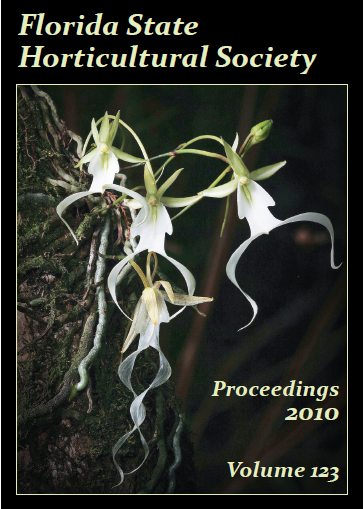Citrus
Monitoring Trees Infected with Huanglongbing in a Commercial Grove Receiving Nutritional/SAR Foliar Sprays in Southwest Florida
Abstract
Citrus growers Maury Boyd and Tim Willis have had success in maintaining Huanglongbing (HLB) infected trees using a cocktail mix of nutrients and SAR (Systemic Acquired Resistance) inducing materials. The Orange Hammock grove in Felda, FL, was first confirmed to have trees infected with HLB in 2006. Since 2006 the trees have been maintained and kept productive with an excellent crop of fruit in 2010. Two plots of ‘Valencia’ on Swingle citrumelo rootstock containing 100 trees (10 rows of 10 trees per row) each were PCR tested in 2008 and in 2010. One plot contained mature trees planted in 1992 and the other plot of younger trees planted in 1999. All trees in both plots were rated in 2010 for symptoms of HLB using a 0 to 5 scale where 0 = tree vigorous, no symptoms of HLB to 5 = tree in permanent decline. At the same time, leaf samples were collected from each tree and processed by real-time PCR for detection of the HLB bacteria at the U.S. Sugar (both years) and HLB Diagnostic lab at SWFREC (2010 only). Results indicated that the percentage of HLB positive trees in the young trees increased from 81% in 2008 to 100% in 2010. The mature trees tested 40% positive in 2008, and were 92% positive in 2010. In 2010, the disease severity on young trees using the 0 to 5 scale rated 50% of the trees as 3 or greater (3 = moderate decline; symptoms of HLB). The disease rating on mature trees was less severe by comparison with less than 20% rated 3 or above.References
- Giles, Frank. 2009. An alternative approach. Florida Grower 102:6–8.
- Li, W., J.S. Hartung, and L.E. Levy. 2006. Quantitative real-time PCR for detection and identification of Candidatus Liberibacter species associated with citrus huanglongbing. J. Microbiological Methods 66:104–115.

